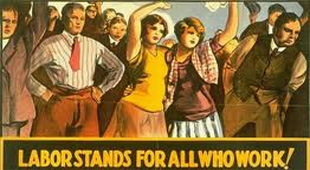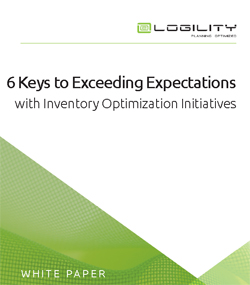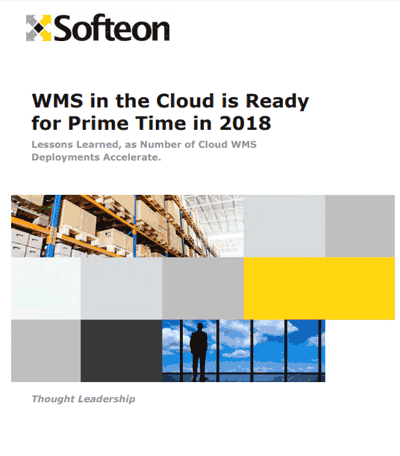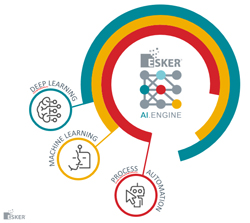The Labor (Day) Supply Chain 2018
Monday of course marks the annual Labor Day holiday both here and in Canada. Starting in 2011, I decided to do a column on the state of the labor supply chain in conjunction with this event. It was popular enough that I have continued on each year since. It's a lot of work, but well worth it.
The last year was not great for labor, but it was better than most recent years, and some in labor are claiming a bit of (wobbly) momentum.
The percent of total US workers that are union members held steady in 2017 at 10.7%, the same as 2016 and down from 11.1% in 2015, according to the US Bureau of Labor Statistics. Unionization in the private sector was up just a tick to just 6.5% versus 6.4% in 2016, but down from 6.7% in 2015.
Conversely, union membership in the public sector was 34.4% last year, the same as in 2016, although for reasons not clear down from a rate of 35.2% in 2015.
| GILMORE SAYS: |
Inflation in warehouse wages is finally starting to take hold, as one would expect in the face of such demand. It's way overdue, actually.
WHAT DO YOU SAY?
Send us your
Feedback here
|
All this of course continues the powerful long-term trend of a steady decline since the Labor Department started reporting on it in 1983, when overall unionization was at 20.1% and at 16.8% in the private sector. Those numbers themselves were well down from previous decades before this metric was officially tracked by the government.
I will note part of that decline in private sector unionization rates is due to the loss of some 7 million US manufacturing jobs since 1983, as manufacturing is clearly more organized than the service sector, but that is far from the only factor. Unions have clearly lost appeal to many, especially in the South, where many new manufacturing factories have been headed for some two decades.
Together, there were 14.8 million private and public sector employees in a union in 2017, up a few hundred thousand from 2016, mostly the result of the overall growth in jobs. But compare that to the 17.7 million union members in 1983, when the total US labor force was much smaller.
There are also huge differences between states. Nine states had union membership rates below 5.0 percent in 2017, up from five in 2016. South Carolina had the lowest rate (2.6%), followed by North Carolina (3.4%) and Utah (3.9%). Conversely, just two states had union membership rates over 20% in 2017: New York (23.8%) and Hawaii (21.3%). Other high union states are Alaska (18.1%), Connecticut (16.9%) and Washington (18.8%).
All told, union membership rates increased over the year in 25 states and the District of Columbia, decreased in 21 states, and were unchanged in 4 states..
The number of US manufacturing workers that are union members also rose a bit to 9.1% last year from 8.8% in 2016. Those numbers are a bit lower than the percent of manufacturing workers covered by union contracts, such as those that opt out in right-to-work states, with coverage of 10.0% last year.
Ponder that - less than one in 11 US manufacturing workers are unionized today, versus 17.5% in 1994. According to unionstats.com, 38% of private sector manufacturing workers were in unions as recently as 1973.
Don't think this downward union trend is only a US phenomenon. Unionization rates in labor-loving Sweden, for example, have fallen from about 90% in the mid-1990s to around 70% today. Many other countries mirror US unionization rates more closely. Unionization in France - generally considered very supportive of labor - almost exactly follow the US patterns, and are actually just below the US in the percent of all workers unionized. Union membership is higher in the UK, at about 23%, but that's down from more like 40% in the mid-1990s. The drop in the UK's total number of union members in 2016 was 4.3%, the largest annual drop recorded since the measure began in 1995.
In July, there were about 8.95 million non-supervisory manufacturing workers in the US, up decently from 8.72 million a year ago. That is also up from the bottom of the recession, when we fell to about 8 million shop floor workers, meaning we've added about almost one million manufacturing jobs since then. But in 2004, there were just over 10 million factory floor workers - we're down just over 1 million positions from that level, and much more from the 1990s.
That obviously puts general downward pressure on wages, as the demand for workers is simply much lower than the supply, though the lack of wage growth isn't nearly as bad as I would have guessed, based on all the media reports.
According to the BLS, the average hourly wage (I believe including benefits) for shop floor manufacturing workers was about $21.44 in July, up from $20.88 in 2017, or about 2.2% growth year over year - not too bad.
That's also up from the $17.75 or so per hour in July 2008, or a rise of 20.8% over 10 years. That's a cumulative growth rate of 1.91%. So wages have risen modestly, about equal with inflation, and thus not enough to improve a worker's lifestyle, especially while healthcare costs take more and more of the paycheck.
Meanwhile, there has been very steady growth in non-supervisory warehouse jobs, though they represent just a tiny fraction of manufacturing positions. There are now about 904,000 warehouse workers in the US, up sharply from some 837,000 in June 2017, an huge increase of 8%. The number is substantially higher than the 590,000 warehouse workers in 2008, a rise of 53% over 10 years - but even with that growth they only represent about 9.6% of manufacturing floor jobs. That surprises me, actually, though that percentage continues to slowly tick up. (I'll note some jobs at plant warehouses are counted as manufacturing positions.)
In terms of wages, average non-supervisory pay for warehouse workers was $17.79 in June, up 5% versus 2017 after an incredibly sharp 11.2% jump last year. That's also about 20% less than average manufacturing rate - but the gap is shrinking. It was 23% in 2016. Pay for warehouse workers was at $15.15 in June 2008, meaning DC wages have risen only 17.4% over the past decade.
And the majority of that increase has happened in the past two years. Average pay was still only just $15.79 in June of 2016. Inflation in warehouse wages is finally starting to take hold, as one would expect in the face of such demand. It's way overdue, actually.
We've heard of $18+ per hour just in wages in some tight markets. The DC labor situation is almost at crisis levels right now. (As a side note, I will be moderating a panel discussion on this topic at the enVista Fuel conference Sept. 20, in part discussing how labor management can help address the problem).
 There really wasn't a critical unionization vote over the past year, versus several high profile organization drives in the past few years, including at Boeing in South Carolina, Volkswagen in Tennessee, and a Nissan plant in Mississippi. Unions lost all three of those votes and rather badly. There really wasn't a critical unionization vote over the past year, versus several high profile organization drives in the past few years, including at Boeing in South Carolina, Volkswagen in Tennessee, and a Nissan plant in Mississippi. Unions lost all three of those votes and rather badly.
But interestingly, on May 31st, 178 workers at Boeing's smaller factory in North Charleston, SC in fact voted to unionize that operation.
Labor strikes, once such a commonplace event, have almost disappeared. A few times in recent years, there have been strikes that were positioned in the media as "labor's last stand," such as a strike at a Caterpillar plant in Illinois in 2017, which largely ended in Caterpillar's favor.
I did not see or find such a major labor action in the last year. In fact, Michael LeRoy, a University of Illinois law professor who specializes in labor relations, said there were only seven strikes last year involving more than 1,000 workers, versus 69 in 1986 and 276 in 1976. Labor law tilts so far in favor of management that "strikes amount to career suicide for most workers," LeRoy says.
But watch for this one: labor contracts at US Steel and giant ArcelorMittal end this week, and the unions are looking for blood, after big givebacks in the last contract.
However, what looked like a setback for labor in the past year ended as a draw. In early 2018, the Missouri legislature voted to adopt a "right to work" policy, in which employees can't be compelled to join unions. Once mostly found only in Southern and some Western states, recently states in the Midwest have jumped on the bandwagon despite furious opposition from labor.
With the vote to become the 28th right-to-work state, Missouri joined Kentucky earlier in the year and Michigan, Wisconsin and Indiana in prior years. But labor forces in the Show Me state were able to force the issue on to the ballot, and this summer it was soundly defeated by voters, after labor outspent its opponents on the measure 5 to 1.
Right-to-work activity that seemed likely to succeed in the Ohio and New Hampshire legislatures last year have also gone nowhere.
The $15 minimum wage movement continued on, but slowly. The state of North Carolina recently voted for a $15 minimum for state workers, to be phased in over several years. Even in California, it's a dollar per year increase that will take four years to hit 15 bucks. Disney announced plans for a $15 minimum wage for its service workers by 2021, with smaller increases immediately.
On the legal front, there was a big blow to labor in 2018, when US Supreme Court decided that public-sector unions could no longer mandate union fees as a condition of employment.
So it was a so-so year for labor, but there we a couple of bright spots.
UPS and East/Gulf Coast port workers each reached agreements before contract expiration in deals for which both sides can claim wins, though the Longshoremen deal largely blocks automation for six years.
Just this week, news that Target employees at a store on Long Island will take a union vote next week after getting the green light from the National Labor Relations Board. That's a first - and could start a trend.
In mid-August, a group of 90 grocery home delivery drivers working for Safeway.com in the Seattle area ratified a contract with the Teamsters. The vote is believed to mark the first time that truck drivers for on-line grocery home delivery have unionized and secured a contract.
Most consequentially, in April the California Supreme Court ruled that a group of delivery drivers were not contractors but should be classified as employees of carrier Dynamex, establishing a tough new test for whether a worker can be given contractor status. Only in the Golden state for now, but watch out!
There's a lot more, but I am well out of space. The issue for labor is still not yet "here come the robots," but will be soon.
Any reaction to our summary of the labor supply chain 2018? Let us know your thoughts at the Feedback button below. |



![]()

![]()

![]()

![]()















